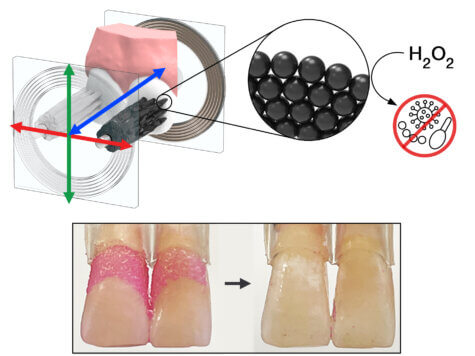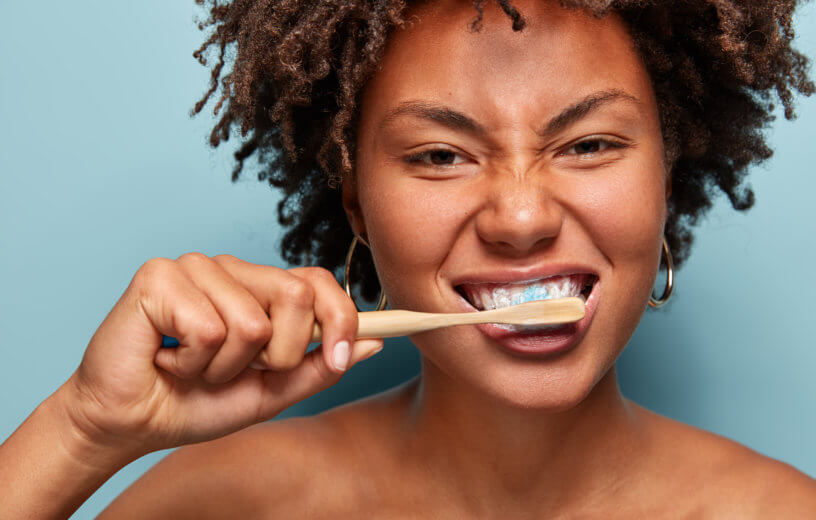
PHILADELPHIA — A “shapeshifting robotic microswarm” of nanobots could be in your future for flossing and brushing your teeth! Researchers from the University of Pennsylvania say their microscopic dentists “may one day act as a toothbrush, rinse, and dental floss in one.”
Using a magnetic field, researchers say they can direct the microrobots’ motion and configuration to form either bristle-like structures like a toothbrush, or elongated strings that can slip between teeth like dental floss. In either case, the building blocks of these tiny robots contain iron oxide nanoparticles, which produce both catalytic and magnetic reactions.
The catalytic reaction drives the nanoparticles to produce antimicrobials that can kill harmful bacteria on a person’s teeth or gums. The team’s experiments demonstrated that the robots could conform to the shape of a person’s teeth — even if they’re crooked — and eliminate all of the biofilms that cause tooth decay and gum disease.
“Routine oral care is cumbersome and can pose challenges for many people, especially those who have hard time cleaning their teeth” says Hyun (Michel) Koo, a professor in the Department of Orthodontics and divisions of Community Oral Health and Pediatric Dentistry in Penn’s School of Dental Medicine, in a university release. “You have to brush your teeth, then floss your teeth, then rinse your mouth; it’s a manual, multistep process. The big innovation here is that the robotics system can do all three in a single, hands-free, automated way.”
“Nanoparticles can be shaped and controlled with magnetic fields in surprising ways,” adds Edward Steager, a senior research investigator in Penn’s School of Engineering and Applied Science. “We form bristles that can extend, sweep, and even transfer back and forth across a space, much like flossing. The way it works is similar to how a robotic arm might reach out and clean a surface. The system can be programmed to do the nanoparticle assembly and motion control automatically.”

The next generation of dental care is here
“The design of the toothbrush has remained relatively unchanged for millennia,” Koo explains, adding that even electric toothbrushes still use the bristle-on-a-stick template. “It’s a technology that has not been disrupted in decades.”
Interestingly, the team’s robotic breakthrough started as two separate projects. Koo’s group was trying to harness the catalytic activity of nanoparticles to release free radicals that would kill tooth decay-causing bacteria. Meanwhile, Steager’s team was studying how nanoparticles could serve as building blocks for magnetically controlled microrobots.
Their collaboration married the two ideas, creating a platform to electromagnetically control the microrobots and have them change their shape to release antimicrobials that clean teeth.
Specifically, the iron particles self-assemble in the presence of a magnetic field. Then, the field can be manipulated to change the shape of the nanoparticle structure to adapt to the teeth and gums. As a byproduct of the process, the nanoparticles generate free radicals that help eliminate bacteria and pathogens.
“It doesn’t matter if you have straight teeth or misaligned teeth, it will adapt to different surfaces,” Koo adds. “The system can adjust to all the nooks and crannies in the oral cavity.”
Are the robots safe for human mouths?
The researchers note that bristles can become firm enough to clean but soft enough to not hurt the user! Tests of the bristle formations on animals revealed that they did not harm the gum tissue. Researchers are fine tuning the system with hopes to see it help people in a clinical setting or even at home — especially for aging adults and people with disabilities who lack the motor skills to regularly brush.
“We have this technology that’s as or more effective as brushing and flossing your teeth but doesn’t require manual dexterity,” Koo concludes. “We’d love to see this helping the geriatric population and people with disabilities. We believe it will disrupt current modalities and majorly advance oral health care.”
The study is published in the journal ACS Nano.
